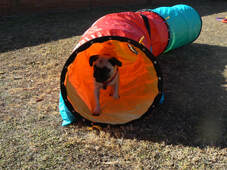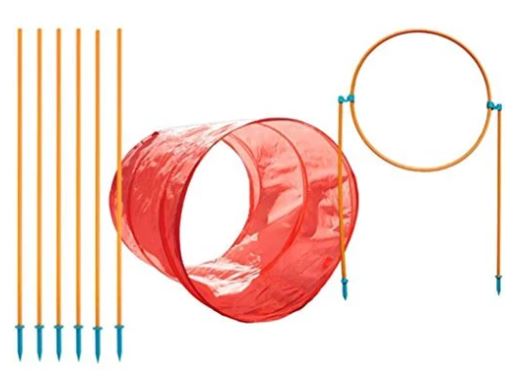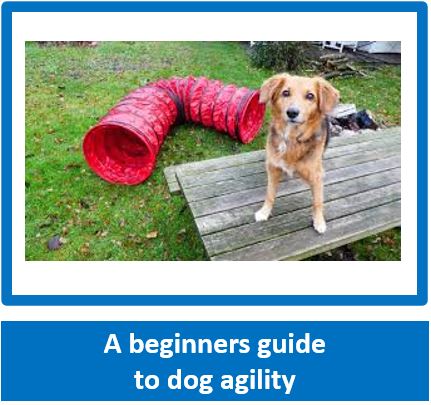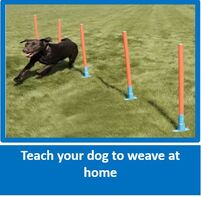Above available at www.mcmac.co.za, plus have a look at our Rosewood Agility Options as well
Which dogs benefit the most from home agility?
by Scotty Valadao - Canine Behaviourist - www.friendsofthedog.co.za
by Scotty Valadao - Canine Behaviourist - www.friendsofthedog.co.za
After seeing an agility course competition on TV and seeing how much dogs enjoy running through tunnels and weaving through poles, many dog owners would love to do this with their dogs but may not have the time to actually take their dogs to agility training or may not have the breed of dog normally suited to this sport – don’t worry there is an alternative – having a small agility course in the garden, or even one adapted to use in the home!
Which breeds or dogs can do agility in the home environment?
All healthy adult dogs, regardless of breed would benefit from agility in the garden – why?
Below are some ideas for you to consider that you could build or utilize from items in the home. Personally, I have found that purchasing the pre-made agility items is a much better option. They all dismantle and can be placed inside a bag for easy storage and carrying. You can even take your bag with you to a larger outdoor area than your garden if you need more space.
Another aspect to bear in mind, is to put together something your dog will prefer. Some dogs love jumps, other love weaving and for some, their favourite is to go over a jump and then dash through a tunnel!
Jumps
You don’t need to have a ton of jumps in your course, just start with one or two and add more as you increase the size of your course.
If you are not buying the pre-made sets of jumps, if you are handy, or have a willing hardware shop that will help, you can make hurdles from pre-cut OVC pipes and joints. Ideally, you want to have the option of changing the height and drilling holes at different levels, where a holder for the jumps can be inserted, can help with this.
Another thing you can use for jumps is to use a hula hoop and attach a pole to either side and insert in the ground. To raise the height, you just use longer poles.
Before the pre-made options were on the market, I used buckets and got the hardware to drill holes in them where I could insert PVC poles at different heights. These are light enough that if your dog knocks it, will fall over.
Solid box
Having a solid box that is strong enough to hold your dog and the right height, is a great addition to your agility course. Your dog can be taught to jump up onto it, sit or down, before going onto the next obstacle.
Weave poles
Once taught how to use these, the majority of dogs love them, and the more confident they become, the faster they like to go through them. If not using one that are purchased, just google to find ideas of how to make your own. They can either be made that they all join together on the floor, or have a peg to insert in the grass, or even start with the orange cones that are found around road works – ideally you would want them taller if a bigger dog, but an idea to get started with.
Which breeds or dogs can do agility in the home environment?
All healthy adult dogs, regardless of breed would benefit from agility in the garden – why?
- It provides different, stimulating, additional exercise.
- Great for a dog that has excess energy and not just physical aspect, the mental stimulation is very important.
- It improves obedience as well as building your bond, as the dog will have to learn to sit and wait before going over a jump, how to take direction, how to weave through poles etc.
- It teaches a dog to think and use his mental abilities as they have to learn new cues and how to maneuverer through obstacles. Also good to improve spatial awareness or Proprioception.
- Gentle agility training is even great for the more senior dogs as long as no physical concerns, as it provides great mental exercise, even though the dog may move slower and be restricted in what it can achieve.
- It helps to relieve boredom related behaviours such as digging and barking
- Agility training is wonderful for dogs that tend to be a bit anxious or nervous as it builds confidence – always work slowly with dogs like this, letting them be successful at one thing at a time before moving onto something new.
- Helps to keep the body more flexible. We all know that as dogs get older their joints can loose some of their mobility and regular practice can help keep joints mobile.
- It’s FUN, for both dog and owner!
- Before you start to put your agility course together, consider how fit your dog is, its age and its weight. Although an overweight dog will benefit from agility, you have to build up slowly – discuss this with your vet.
- Place your obstacles on solid ground and as flat as possible to avoid accidents.
- Although pups can have great fun going over tiny obstacles and learn how to weave and go though small tunnels, it will depend very much on your pup’s age, and whether the Growth Plates have closed. A pup should not go over any jumps higher than wrist height until 6 months of age, and no jumping higher than elbow height until 12 – 18 months of age.
- The pup should not go over any jumps higher than wrist height until 6 months old, and no jumping higher than the elbow height until 12 – 18 months of age depending on the size of the dog – rather check with a vet.
- Work slowly and never challenge your dog beyond its ability. This will help to build confidence and of course, prevent any accidents.
- This should be a fun occurrence for you both – no shouting or punishing if the dog does not comply – work slowly and in increments, remember that learning to do something new can be fun – you also don’t want your dog to become frustrated.
- Ensure that the objects you are using are safe, with no sharp corners, and are sturdy, if not using the portable agility kits you can buy online.
- If you are making your own jumps, by placing on top of things such as buckets, make sure that they are not solid in the event that the dog knocks it.
- Don’t leave the agility articles you are using lying around when you are not working – rather have a bag and a place to store them – not only will they last longer, that they are not available to the dog all the time will increase their importance to the dog, and something they look forward to doing.
Below are some ideas for you to consider that you could build or utilize from items in the home. Personally, I have found that purchasing the pre-made agility items is a much better option. They all dismantle and can be placed inside a bag for easy storage and carrying. You can even take your bag with you to a larger outdoor area than your garden if you need more space.
Another aspect to bear in mind, is to put together something your dog will prefer. Some dogs love jumps, other love weaving and for some, their favourite is to go over a jump and then dash through a tunnel!
Jumps
You don’t need to have a ton of jumps in your course, just start with one or two and add more as you increase the size of your course.
If you are not buying the pre-made sets of jumps, if you are handy, or have a willing hardware shop that will help, you can make hurdles from pre-cut OVC pipes and joints. Ideally, you want to have the option of changing the height and drilling holes at different levels, where a holder for the jumps can be inserted, can help with this.
Another thing you can use for jumps is to use a hula hoop and attach a pole to either side and insert in the ground. To raise the height, you just use longer poles.
Before the pre-made options were on the market, I used buckets and got the hardware to drill holes in them where I could insert PVC poles at different heights. These are light enough that if your dog knocks it, will fall over.
Solid box
Having a solid box that is strong enough to hold your dog and the right height, is a great addition to your agility course. Your dog can be taught to jump up onto it, sit or down, before going onto the next obstacle.
Weave poles
Once taught how to use these, the majority of dogs love them, and the more confident they become, the faster they like to go through them. If not using one that are purchased, just google to find ideas of how to make your own. They can either be made that they all join together on the floor, or have a peg to insert in the grass, or even start with the orange cones that are found around road works – ideally you would want them taller if a bigger dog, but an idea to get started with.
 the above pic is just 2 small tunnels fastened together, which can be separated after use and packed away.
the above pic is just 2 small tunnels fastened together, which can be separated after use and packed away.
Tunnels
These can also be purchased pre-made and come in different sizes. For home fun, rather consider the shorter one’s of just over a metre. Depending on the size of your dog, you may be able to use kids tunnels – just make sure that easily fit the size of your dog and that the tunnel can be secured to the ground with poles on either side that can be pegged in the ground, or a hoop going over the top that can be pegged – if you don’t, you may find your dog running around the garden with a tunnel attached!
If you have a large box, and open at both sides, this can be considered, but does not last long. Alternatively, consider a laundry basket for smaller dogs and take off the top and bottom. This can also be put against the house and your poles stored inside it.
Tyres
Old tyres can be used in an agility course where your dog just has to go in one side and out the other, and you can even put a few against one another to make a longer obstacle.
You can teach your dog to either jump over them, go around them, or some other great ideas as in the this link to a video - great ideas!
See saws, ramps and A Frames
Honestly, if you are going to use one of these, rather purchase from a company that sells agility equipment, that is adjustable and is strong enough, unless your have a really DIY person you know that can make it for you.
You can, however, make a balance plank by placing a plank on top of two types a few feet away from one another. Just make sure that it is wide enough to accommodate your dog.
These can also be purchased pre-made and come in different sizes. For home fun, rather consider the shorter one’s of just over a metre. Depending on the size of your dog, you may be able to use kids tunnels – just make sure that easily fit the size of your dog and that the tunnel can be secured to the ground with poles on either side that can be pegged in the ground, or a hoop going over the top that can be pegged – if you don’t, you may find your dog running around the garden with a tunnel attached!
If you have a large box, and open at both sides, this can be considered, but does not last long. Alternatively, consider a laundry basket for smaller dogs and take off the top and bottom. This can also be put against the house and your poles stored inside it.
Tyres
Old tyres can be used in an agility course where your dog just has to go in one side and out the other, and you can even put a few against one another to make a longer obstacle.
You can teach your dog to either jump over them, go around them, or some other great ideas as in the this link to a video - great ideas!
See saws, ramps and A Frames
Honestly, if you are going to use one of these, rather purchase from a company that sells agility equipment, that is adjustable and is strong enough, unless your have a really DIY person you know that can make it for you.
You can, however, make a balance plank by placing a plank on top of two types a few feet away from one another. Just make sure that it is wide enough to accommodate your dog.






